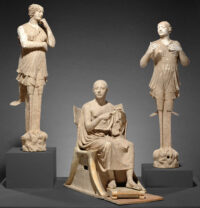 The J. Paul Getty Museum in Los Angeles is returning one of its greatest treasures to Italy: a group of life-sized terracotta statues of a seated poet with two sirens from the 4th century B.C. The sculptural group was bought by J. Paul Getty himself and has been on display continuously since 1976. An unrelated investigation by the Manhattan District Attorney’s Antiquities Trafficking Unit following the loot-strewn trail of antiquities trafficker Gianfranco Becchina uncovered evidence that the sculptures had been illegally excavated and exported shortly before they were fenced to the Getty.
The J. Paul Getty Museum in Los Angeles is returning one of its greatest treasures to Italy: a group of life-sized terracotta statues of a seated poet with two sirens from the 4th century B.C. The sculptural group was bought by J. Paul Getty himself and has been on display continuously since 1976. An unrelated investigation by the Manhattan District Attorney’s Antiquities Trafficking Unit following the loot-strewn trail of antiquities trafficker Gianfranco Becchina uncovered evidence that the sculptures had been illegally excavated and exported shortly before they were fenced to the Getty.
The sculptures were crafted around 350-300 B.C. in the Greek colony of Tarentum in the heel of Italy’s boot, today the region of Puglia. The sirens have the heads and torsos of women with the legs and talons of birds gripping rocky perches. They wear short, wind-swept chitons strapped over the breasts. The poet is seated and holding a plektron (a lyre pick) in his right hand. The lyre that was once in the crook of his left arm is lost. They are virtually complete, and even some of the hair curls broken off the head of one of the sirens are still with the group, so vanishingly rare a circumstance that it alone should have telegraphed that the group was dug up intact and smuggled out of the country. It was originally painted in vivid colors, and there are rare surviving traces of that original polychromy still visible on the terracotta surface.
“It is a very important work. I’d even say one of the most important in the [Getty Museum’s] collection,” Getty Museum director Timothy Potts said in an interview. “So it will be a loss as to what we can represent about the art of the ancient classical world, in this case southern Italy in the late fourth century B.C.”
Potts said the work is especially unique because of its scale, quality and subject matter — it suggests the mythical story of Jason and the Argonauts, which would make the sculpture’s seated man, who plays a harp-like instrument, Orpheus.
“It’s just extremely rare and there’s nothing similar in our collection, or closely similar in any collection,” Potts said. “It does leave a hole in our gallery but with this evidence that came forth, there was no question that it needed to be sent back to Italy.”
The group was one of the last archaeological treasures acquired by J. Paul Getty before his death in June of 1976. He wrote in his diary entry from March 6th, 1976:
Bought the following objects: [long list of antiquities, their cost and who he bought them from.] A group of 3 Greek statues made in Tarentum at the end of the 4th c. B.C. They represent a singer Orpheus seated and 2 standing sirens, $550,000 from Bank Leu. All these naturally were on Frel’s recommendation.
Bank Leu was a bank in Zurich, a classic middleman for the traffic in looted antiquities. Frel was Jiří Frel, the Getty Museum’s antiquities curator at the time. The 550K Getty paid for the terracotta group is the equivalent of about $3 million today, but its current market value was assessed by the Trafficking Unit as $8 million.
The group has been removed from display and Getty experts are now figuring out how to ship the fragile objects to Italy without damaging them. Custom equipment will be involved. The sculptures will be repatriated to Italy next month. After a short stint on display at Rome’s new Museum of Rescued Art, the group will go on permanent display in their hometown of Taranto.
On their route back to Greece, Jason and the Argonauts –with the singer Orpheus aboard– actually were passing by what would become the Greek colony of ‘Tarentum’ at the heel of Italy’s boot.
Here, Orpheus successfully restrains the Sirens by chanting a counter-melody. The Sirens threw themselves headlong from the heights down to the depths of the unquiet sea, in which their bodies were changed into rocks.
The terracotta Sirens look gorgeous, but indeed also slightly concerned 😮